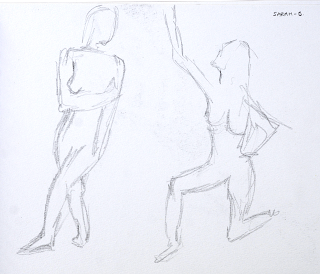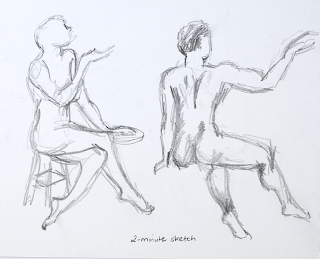As it is hard for me to know what contemporary artists are currently depicting the underlying structure of the body, I researched the artists mentioned in WeAreOCA, 4 July 2016, in the article “Facing the World | Self-Portraits Rembrandt to Ai WeiweiI”. (Joanne, 4 July 2016)
Although I did not find work by Alison Watt relating to the human figure, I found her execution of drapery folds very appealing. After studying folds in the initial exercises in this section, I found her huge installations comprising of canvases painted with oils to look photographic in their detail, to be quite challenging. I would absolutely love to be able to see these in real life, and not online.
An artist, whose depiction of the human anatomy is quite disturbing, is the Scottish artist, Ken Currie. The Anatomy Lesson (fig. 2) harks back to Rembrandt’s picture of a similar title,
 |
Figure 1. Rembrandt,
The Anatomy Lesson of Dr. Nicolaes Tulp,
signed and dated ‘Rembrandt ft. 1632’.
|
The Anatomy lesson of Dr Nicolaes Tulp. (fig.1) The main stark difference in Currie’s rendition of this age-old theme is that his subject is a seated figure of an elderly woman, who despite her gaunt facial features and thin arms has emphasized hips, breasts, and stomach. The onlookers are not the eager students of Dr. Tulp, but rather ghoulish, grumpy old men who are peering at her form with disparaging looks. Currie’s attention to the detail of the pulling of her skin around her arms and hips conveys the idea of the hardness of her life and the aging of her body. The harsh scar up her torso gives the idea that her organs have been examined by an autopsy, yet her facial expression indicates that she might still be living. It is a very somber piece. When reading up about him in Susan Mansfield’s interview it is interesting that he is quoted as saying, “Even as student, I had a complete abhorrence of the life room, I couldn’t stand this idea of doing mechanical recording of a figure in front of me, it felt like a complete abnegation of the ability to think, to use your imagination.” (Mansfield) His contempt for life drawings can be seen in this portion of the polypytych as the onlookers dehumanize their vulnerable female sitter.
 |
Figure. 2. Anatomy
Lesson
(polyptych, right panel),
Ken
Currie (b.1960
|
Another main difference is the focus of the artwork. In Rembrandt’s painting the “viewer’s attention is focused on Tulp, who demonstrates how the muscles of the arm are attached. The corpse’s arm has been laid open for the purpose.” (Museum Het Rembrandthuis) However, in Ken Currie’s artwork the viewer’s attention is drawn to the hollow expression of the female figure and then the cross that forms between her sagging breasts and the long incision running down her torso.
I looked at further works of Currie and found more meaty depictions of the interior structure of the body. These artworks hark back to the images of Francis Bacon. It is interesting that despite the fact that I spent a few hours studying the plastinate bodies of real humans in the exhibition Body World, his depiction of the internal workings of the body are disturbing. He emphasizes the degradation and flaying of body to open its structure to the viewer’s eyes. The bodies in his Tragic Forms series appear tortured and brutalized. (Artsy.net)
Another artist mentioned by the WeAreOCA article, Tracey Emin, also demands attention in her nude self-portraits. In her case, the raw, in-your-face sexuality of her figures totally puts me off. However, as an Expressionist artist, but I think that is exactly what she is trying to evoke in her viewer. She seems to want to portray that she, as a female, has been over-sexualized and dehumanized by the fact that she is not seen for anything other than as a sex object. (Artnet)
 |
| Figure 3. Hands Spread on Knees, 1985. John Coplans. |
As I enjoy drawing hands, and knees have always fascinated me, due to my being teased for my freckly knees as a child, I found the photographic study Hands on Knees, 1985, by John Coplans particularly appealing. (artnet.com) (fig.3) What makes it appealing is its emphasis on the differences in textures and tones. The hands grip the knees, causing the blood vessels to bulge and the skin around the knees to become more wrinkled than normal. This emphasizes the texture of the aging man’s hairy skin.
This research has led me to see how important the understanding of the structure of the human anatomy can be in the creation of expressive artworks that go beyond merely depicting the visual appearance of the anatomy. In each of these artworks mentioned, the viewer is left with strong feelings towards the body being depicted, communicated in the attention to particular details of the anatomy and in a style which demands your attention.
Works Cited
artnet.com, n.d. Carl Solway Gallery. [Online]
[Accessed 11 July 2016].
Artnet, n.d. Tracy Emin. [Online]
[Accessed 11 July 2016].
Artsy.net, n.d. Ken Curie. [Online]
[Accessed 1 July 2016].
Joanne, 4 July 2016. Facing the World | Self-Portraits Rembrandt to Ai Weiwei. WeAreOCA
Mansfield, S., 2013. Interview Ken Currie on the Terror of Mortality. [Online]
[Accessed 11 July 2016].
Museum Het Rembrandthuis, n.d. The Anatomy lesson of Dr Nicolaes Tulp. [Online]
[Accessed 11 July 2016].
Illustrations
Figure 1. Rembrandt Van Rijn. The Anatomy Lesson of Dr Nicolaes Tulp. [Art] (Museum Het Rembrandthuis).
Figure 2. Currie, K., n.d. Anatomy Lesson (polyptych, right panel). [Art] (Middlesbrough Institure of Modern Art).
Figure 3. Coplans, J., 1985. Hands Spread on Knees. [Art].
















































